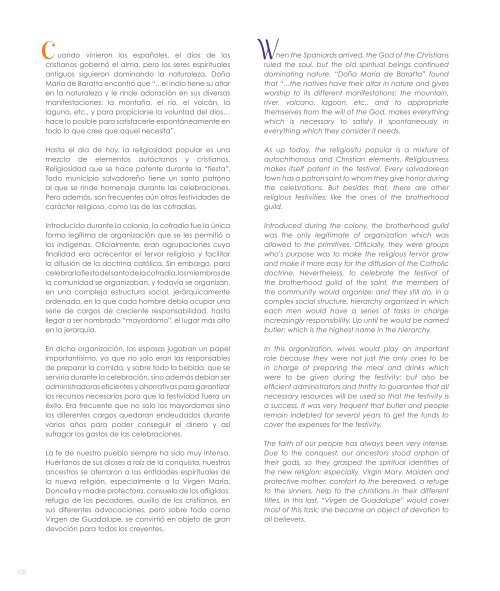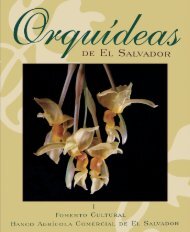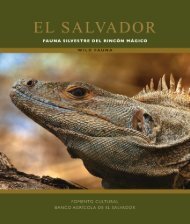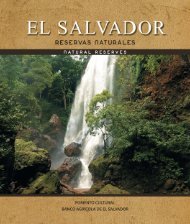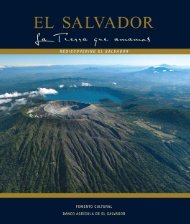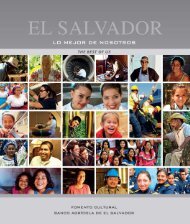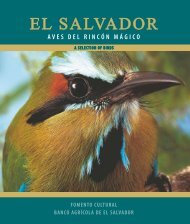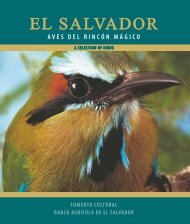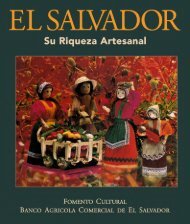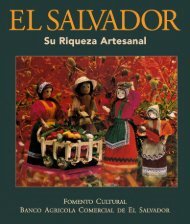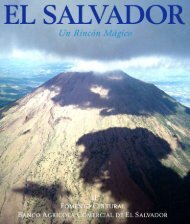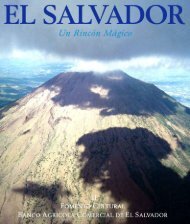Fiestas Patronales del Rincón Mágico
Create successful ePaper yourself
Turn your PDF publications into a flip-book with our unique Google optimized e-Paper software.
uando vinieron los españoles, el dios de los<br />
cristianos gobernó el alma, pero los seres espirituales<br />
antiguos siguieron dominando la naturaleza. Doña<br />
María de Baratta encontró que “…el indio tiene su altar<br />
en la naturaleza y le rinde adoración en sus diversas<br />
manifestaciones: la montaña, el río, el volcán, la<br />
laguna, etc., y para propiciarse la voluntad <strong>del</strong> dios…<br />
hace lo posible para satisfacerle espontáneamente en<br />
todo lo que cree que aquel necesita”.<br />
Hasta el día de hoy, la religiosidad popular es una<br />
mezcla de elementos autóctonos y cristianos.<br />
Religiosidad que se hace patente durante la “fiesta”.<br />
Todo municipio salvadoreño tiene un santo patrono<br />
al que se rinde homenaje durante las celebraciones.<br />
Pero además, son frecuentes aún otras festividades de<br />
carácter religioso, como las de las cofradías.<br />
Introducida durante la colonia, la cofradía fue la única<br />
forma legítima de organización que se les permitió a<br />
los indígenas. Oficialmente, eran agrupaciones cuya<br />
finalidad era acrecentar el fervor religioso y facilitar<br />
la difusión de la doctrina católica. Sin embargo, para<br />
celebrar la fiesta <strong>del</strong> santo de la cofradía, los miembros de<br />
la comunidad se organizaban, y todavía se organizan,<br />
en una compleja estructura social, jerárquicamente<br />
ordenada, en la que cada hombre debía ocupar una<br />
serie de cargos de creciente responsabilidad, hasta<br />
llegar a ser nombrado “mayordomo”, el lugar más alto<br />
en la jerarquía.<br />
En dicha organización, las esposas jugaban un papel<br />
importantísimo, ya que no solo eran las responsables<br />
de preparar la comida, y sobre todo la bebida, que se<br />
serviría durante la celebración, sino además debían ser<br />
administradoras eficientes y ahorrativas para garantizar<br />
los recursos necesarios para que la festividad fuera un<br />
éxito. Era frecuente que no solo los mayordomos sino<br />
los diferentes cargos quedaran endeudados durante<br />
varios años para poder conseguir el dinero y así<br />
sufragar los gastos de las celebraciones.<br />
La fe de nuestro pueblo siempre ha sido muy intensa.<br />
Huérfanos de sus dioses a raíz de la conquista, nuestros<br />
ancestros se aferraron a las entidades espirituales de<br />
la nueva religión, especialmente a la Virgen María.<br />
Doncella y madre protectora, consuelo de los afligidos,<br />
refugio de los pecadores, auxilio de los cristianos, en<br />
sus diferentes advocaciones, pero sobre todo como<br />
Virgen de Guadalupe, se convirtió en objeto de gran<br />
devoción para todos los creyentes.<br />
hen the Spaniards arrived, the God of the Christians<br />
ruled the soul, but the old spiritual beings continued<br />
dominating nature. “Doña Maria de Baratta” found<br />
that “…the natives have their altar in nature and gives<br />
worship to its different manifestations: the mountain,<br />
river, volcano, lagoon, etc., and to appropriate<br />
themselves from the will of the God, makes everything<br />
which is necessary to satisfy it spontaneously in<br />
everything which they consider it needs.<br />
As up today, the religiositu popular is a mixture of<br />
autochthonous and Christian elements. Religiousness<br />
makes itself patent in the festival. Every salvadorean<br />
town has a patron saint to whom they give honor during<br />
the celebrations. But besides that, there are other<br />
religious festivities; like the ones of the brotherhood<br />
guild.<br />
Introduced during the colony, the brotherhood guild<br />
was the only legitimate of organization which was<br />
allowed to the primitives. Officially, they were groups<br />
who’s purpose was to make the religious fervor grow<br />
and make it more easy for the diffusion of the Catholic<br />
doctrine. Nevertheless, to celebrate the festival of<br />
the brotherhood guild of the saint, the members of<br />
the community would organize; and they still do, in a<br />
complex social structure, hierarchy organized in which<br />
each men would have a series of tasks in charge<br />
increasingly responsibility. Up until he would be named<br />
butler; which is the highest name in the hierarchy.<br />
In this organization, wives would play an important<br />
role because they were not just the only ones to be<br />
in charge of preparing the meal and drinks which<br />
were to be given during the festivity; but also be<br />
efficient administrators and thrifty to guarantee that all<br />
necessary resources will be used so that the festivity is<br />
a success. It was very frequent that butler and people<br />
remain indebted for several years to get the funds to<br />
cover the expenses for the festivity.<br />
The faith of our people has always been very intense.<br />
Due to the conquest, our ancestors stood orphan of<br />
their gods, so they grasped the spiritual identities of<br />
the new religion; especially, Virgin Mary. Maiden and<br />
protective mother, comfort to the bereaved, a refuge<br />
to the sinners, help to the christians in their different<br />
titles. In this last, “Virgen de Guadalupe” would cover<br />
most of this task; she became an object of devotion to<br />
all believers.<br />
102


